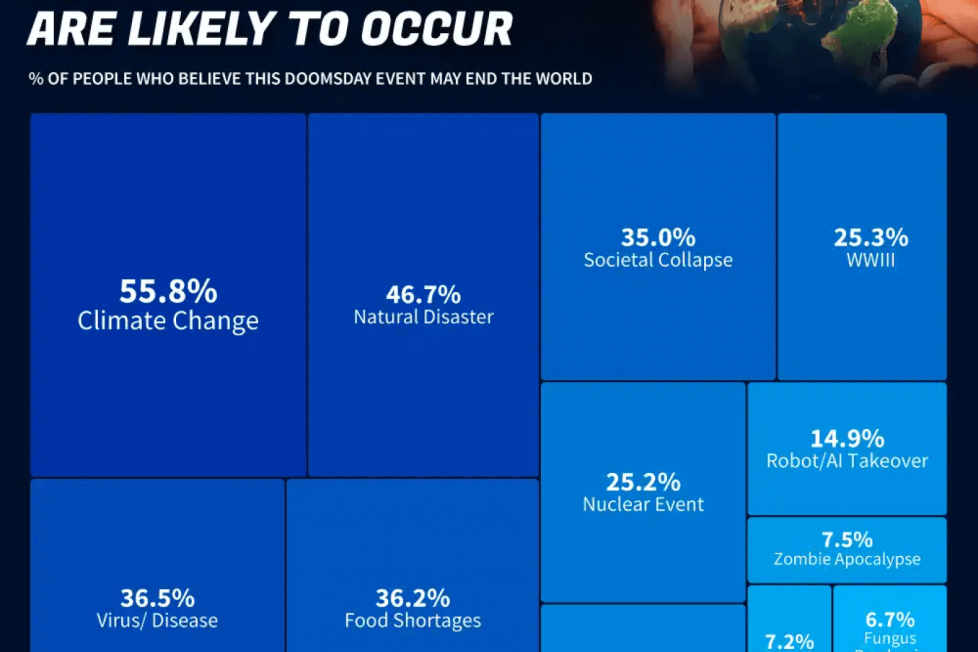American Apocalypse? 71% Don’t Trust U.S. Government To Prevent Doomsday

CHICAGO — U.S. politics continue to be a chaotic subject, and a new poll finds the majority of Americans are rapidly losing faith in their country’s leaders. From the ousting of the Speaker of the House to the mounting controversies engulfing the current president and his predecessor, over seven in 10 people say there’s no one they trust to save them from an end-of-the-world event. Such problems only push the so-called “Doomsday Clock” to tick closer to end times.
Established in 1947 by a group of atomic scientists, including the revered Albert Einstein, the Doomsday Clock serves as a barometer for humanity’s proximity to global annihilation. It is a metaphorical measure of humanity’s vulnerability to cataclysmic events, such as nuclear war, climate change, pandemics, or asteroid impacts. The closer the clock’s hands are to midnight, the closer we presumably are to a doomsday scenario.
According to a survey of 6,200 Americans conducted by BonusFinder.com, 71.2 percent of Americans say they have no faith in the U.S. government to save them or prevent a doomsday event. Even more unnerving, many respondents believe Doomsday could come within the next year.
Over half the poll (55.8%) think Doomsday will come in the form of a climate change-related catastrophe, while a third believe another virus will sweep the globe and a quarter of respondents fear the start of World War III. Another seven percent are betting on an alien invasion, while the same number believe 2024 will finally be the year zombies walk the Earth.
When it comes to the lack of faith in the U.S. government, researchers found that this growing distrust appears to be a bipartisan issue. Researchers found that a staggering 82 percent of respondents in the swing state of Arizona don’t trust the government to protect them from Doomsday. Moreover, 43 percent of these Americans have stored up supplies for a potential disaster.
Following Arizona, the top five states with the least amount of trust in the government include Kansas (78%), Alabama (78%), Pennsylvania (77%), and Oregon (76%).
As for what’s causing so many people to get ready for the potential end of the world, over 16 percent of respondents say social media and the content they consume on these platforms has convinced them to take action. One in 10 say watching the news led them to start doomsday prepping, while 7.7 percent cite their family and 4.6 percent credit watching certain movies.
If you’re thinking of creating your own Doomsday checklist, researchers found that the most popular items people are stocking up on include water (41.2%), warm clothing (39.3%), and extra food (38.2%). Interestingly, one in five are making sure to have extra pet food ready and one in 10 think they’ll need some extra cash when the world ends.
To decipher which U.S. states are prepping for doomsday, surveyors examined the extent of Americans’ preparations and survival plans. A “resilient citizen,” as defined by The Prepared, can survive over 31 days without external aid or utilities. The study utilized this metric to assess the number of resilient citizens in each state.
Leading the pack, Nebraska emerged as the most prepared, with 51.35% of respondents indicating they’ve begun or are considering doomsday preparations. Additionally, 37.84% of Nebraskans are classified as resilient citizens, having stored enough provisions for at least a month.
Montana and New Mexico also rank highly on the list of states preparing for catastrophic events, with 50% and 47.50% of their residents, respectively, making or contemplating preparations. However, in both states, only 30% can boast the status of resilient citizens. On the flip side, Oklahoma appeared least prepared with a mere 28.38% of respondents indicating they’ve stored or intend to stockpile supplies. Idaho followed closely with only 29.41% contemplating preparations.
Interestingly, while Nebraska tops the preparedness chart, it also emerged as the state most confident in surviving a doomsday event. An impressive 64.86% of Nebraskans believe in their survival capabilities in such an event.
Diving deeper into demographics, the survey revealed that men are more likely to prep for doomsday than women, with 18.1% of male participants indicating preparedness compared to 8.8% of female participants. Financially, the majority of respondents invested between $1,000 to $4,999 in disaster preparations, with a few in states like Montana and New Mexico splurging up to $10,000. For those feeling the urgency to prepare, researchers emphasize the importance of storing water, food, shelter, medical supplies, and hygiene items.
BonusFinder.com conducted a uStats.org survey of 6,200 Americans between the dates of Wednesday, May 3, 2023 and Monday, May 8, 2023.
*Please note the following states have been excluded due to less than 20 respondents:
